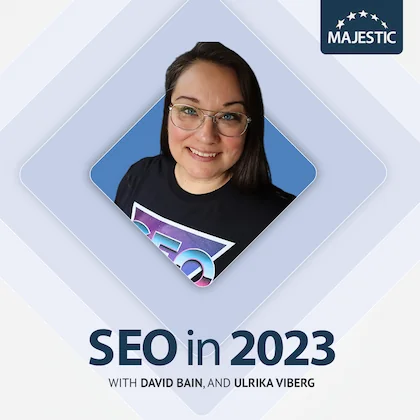-
Site Explorer
- Majestic
- Summary
- Ref Domains
- Backlinks
 New
New Lost
Lost- Context
- Anchor Text
- Pages
- Topics
- Link Graph
- Related Sites
- Advanced Tools
- Author ExplorerBeta
- Summary
- Similar Profiles
- Profile Backlinks
- Attributions
- Compare
-
Link Tools
- My Majestic
- Recent Activity
- Reports
- Campaigns
- Verified Domains
- OpenApps
- API Keys
- Keywords
- Keyword Generator
- Keyword Checker
- Search Explorer
- Link Tools
- Bulk Backlinks
- Neighbourhood Checker
- Submit URLs
- Experimental
- Index Merger
- Link Profile Fight
- Mutual Links
- Solo Links
- PDF Report
- Typo Domain
- Free SEO Tools
-
Support
- Blog

- Support
- Get started
- Tools
- Subscriptions & Billing
- FAQs
- Glossary
- How To Videos
- API Reference Guide

- Contact Us
- About Backlinks and SEO
- SEO in 2024
- Link Building Guides
- Webinars
- Blog
Have a more user-centric holistic approach
Ulrika Viberg
Ulrika Viberg recommends focusing on what the user wants in 2023 and working together with traditional marketing, digital marketing, and the UX team to improve the customer experience through your SEO.

Have a more user-centric holistic approach
Ulrika says: “Be a user-centric, holistic SEO - together with the marketing department and the UX department. That is my number one tip.”
What does a user-centric holistic approach mean in practice?
“If you look at the last couple of algorithm updates, Google has been pointing out that you need to be user-focused. They want to make the web more friendly and truthful. They are pushing for user-centric content that complies with the EAT update. It should be well-designed and accessible for people with hearing and sight impairments, as well as compliant with Core Web Vitals, mobile friendly, etc.
All of that translates to the fact that there needs to be a good user experience. You need to consider the user journey, or customer journey, and it has to be UX-friendly. SEOs working together with marketing departments and UX departments gives a holistic view of what is being created on your website. It makes you think: ‘What does my user really want?’ and ‘What are they asking for?’ rather than ‘What is it that I want to tell them?’”
In a large marketing department, who tends to own the user journey? Is there one distinct, singular perspective on what a user journey is?
“No, there is not. There is an interpretation for each organisation or company. I work with a lot of larger companies, and they don’t always have a clear user journey or customer journey in mind. That is something that I help them with. Usually, it’s the CMO who is taking the lead, but everyone is involved.
I invite the whole marketing department, both traditional and digital marketing - but also the sales department, because they are very close to their customers, maybe more so than the marketing departments are. Then, we create the user journey or the customer journey.
Once they have it, and they have worked through it, it’s something that needs to be talked about throughout the whole organization. Everyone becomes aware of it. It’s a strategic document that they need to follow in everything they do.”
When SEOs are having conversations with the UX team, what can they learn from each other?
“What SEOs can learn from the UX team is that they are very user-centric. Every second sentence they say is: ‘What is the user expecting?’ We, as SEOs, need to learn to think that way, and we need to create content and a strategic way of flowing through the website that focuses on the user’s expectations. That builds into what kind of architecture we are recommending on the site. It has to translate into the user journey.
It’s easier for the user to travel through a website and take in the information if it is designed from a user perspective. What are they expecting? That question translates into each and every individual page. You need to think about what the page is actually about. Look at search intent so that you understand what the user has searched for, what they are expecting to land on, and what kind of information they are expecting to see.
It’s not only about the information, but also how you are presenting it. Are you presenting it in a way that encourages the user to do something after they have read this information? What is it that you want them to do? Here is where you bring in internal linking - in terms of calls to action and everything else. Maybe you have a semantic cluster that you want the user to walk through or get more information about. How do you make it easier for them?
Here is where the UX team will decide how to place things, where to place them, and what to call them. As SEOs, we’re thinking about how we then add internal links, and where that will matter - both in terms of SEO, but also in terms of the user and what they would expect to do next. If they want more information, we need to provide them with that.”
What can SEOs learn about user journeys from more traditional marketing departments?
“I have never worked with traditional marketing myself, but I’ve worked in departments who have done traditional marketing, and it’s all about the understanding of the persona. Who are they?
Traditional marketing can teach SEOs how to paint up a persona and how to categorise that. How are your personas or your users treating information? What are they expecting to see, and how are they processing what they see in traditional media or traditional marketing efforts? We need to think about how we can pick that up and continue that journey into the digital space. They will certainly search for the things they have seen in traditional marketing campaigns.”
If an SEO is in charge of conducting a training session for marketers that don’t know a lot about SEO, what information is key to impart and what information should you not talk about?
“Try to tap into their domain. Talk using their keywords, so to speak, so that they can take it in. I use a lot of metaphors because, for someone who has never done SEO, it can be very theoretical and abstract. To help them understand what I’m talking about, I use metaphors and I try to describe the concepts using situations they understand and are familiar with.
SEO and marketing meet, and they overlap a lot when it comes to the user and what the user expects. All of those are also ranking signals. I tell them that these things that they work with are also important to us. The customer journey is also important for SEO, and I tell them how and why and so on.
I tend to leave out the technical parts because that usually confuses more than it helps. We tend to speak in lingo when we talk technical, and that is a good way to kill a conversation. We don’t want that”
SEOs can be guilty of focusing on driving traffic, and not the whole user journey experience. How can SEOs do a better job of attracting repeat traffic or traffic at different stages of the user journey?
“I actually stopped just measuring traffic some time ago. It is still what we can influence the most but, if we take the next step and work a little bit more holistically, we can influence much more. We can recommend what the content should be and the internal linking, etc., so that we can make the user proceed in their decision-making. In this way, we can have a greater impact on goal completions and conversions.
By giving the user what they are expecting, we are also more likely to create a relationship between the user and the brand. People are lazy. If we have a good relationship with a brand that we once trusted, then we tend to go back to that brand when we want that service or product again. If we were not happy, we carry out a new search the next time the need arises, but if we were happy, then we would probably go back to that brand.
It’s crucial to make the customers happy. That should be self-explanatory, but it’s not always. SEOs can help with that by making recommendations for content, but also internal linking, menus, and how you walk through the website. Of course, it should also load fast and look nice, and not jump up and down or have lots of ads in the way, etc.”
What are your thoughts on attribution and how you can attribute SEO to different touchpoints and channels? Are there any optimal models or pieces of software that you would recommend to show the information decision-makers need in terms of the value of different channels?
“We use contributing models or attribution modelling. You can build attribution models in Google Analytics, to see what channels provide the best traffic and where it was attributed.
In terms of what is currently missing, those models won’t really show that. You would have to do heatmaps, etc. See how people are interacting with the page and actually look at the user. You could do some live testing with live users and ask them questions. You can also do that in smaller tests - they don’t have to be super big or very costly. That’s very useful to do. Then you will see, live, what the users are liking and how they are interpreting the pages that you want to test.”
What shouldn’t SEOs be doing in 2023? What’s seductive in terms of time, but ultimately counterproductive?
“I would love it if SEOs would stop doing isolated keyword optimisation based on search volume. It is counterproductive for the user journey, and for decision-making as a whole.
It creates isolated touchdowns on single pages - and what are they doing then? Just trying to rank number one, or one to three, on a specific high-volume keyword is counterproductive by itself.
If, on the other hand, you create a cluster around that keyword and you think about something you want to do around that keyword, so that users feel that they found what they expected, then that is actually helpful. That would be the next level to go for.""
Ulrika Viberg is Agency Owner and Senior SEO Consultant at Unikorn and you can find her at unikorn.se
Choose Your Own Learning Style
 Video
Video
If you like to get up-close with your favourite SEO experts, these one-to-one interviews might just be for you.
Watch all of our episodes, FREE, on our dedicated SEO in 2023 playlist.
 Podcast
Podcast
Maybe you are more of a listener than a watcher, or prefer to learn while you commute.
SEO in 2023 is available now via all the usual podcast platforms
Don't miss out
Opt-in to receive email updates.
It's the fastest way to find out more about SEO in 2025.
Could we improve this page for you? Please tell us





